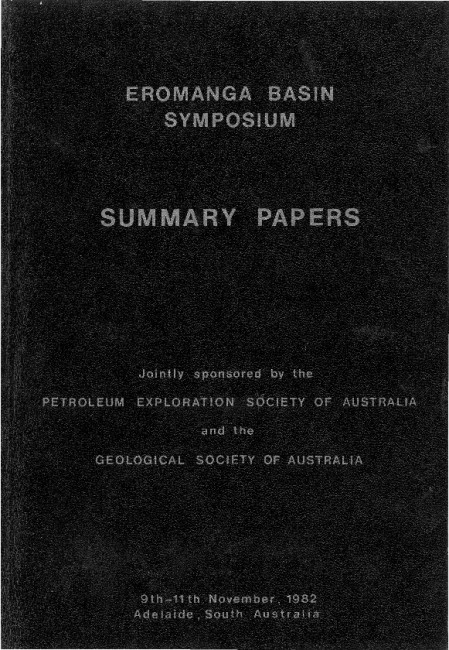Publication Name: Eromanga Basin Symposium, Summary Papers
Authors: G AMBROSEL, R SUTTILL, I LAVERING
Publication Volume: Adelaide, 9 - 11 November 1982
Date Published: December 1982
Number of Pages: 31
Reference Type: Conference Proceedings
Abstract:
In the study area the Murta Member (Mooga Formation) was deposited in anasymm.etric basin formed by compaction of the underlying Cooper Basin
sequence. It is a mainly fine grained lacustrine sequence intervening between
braided fluvial sediments of the Namur Sandstone Member (Mooga Formation) and
the overlying, marginal marine Transition Beds. The lower contact is
transitional and marks a period of degradation of the 'Namur' braided fluvial
regime prior to the onset of lacustrine conditions. Core data indicate a
gradational upward passage from the Murta Member into the basa?l Transition
Beds and there is no conclusive evidence of marine influence until about
midway through the latter. Regional log correlations show the sequence
intertongues with the Namur Sandstone on a regional scale and it is thus
proposed that the unit retain its status as a member of the Mooga Formation.
A reference section is assigned to Dullingari No. 9 where the sequence is
subdivided into four units. The basal unit (Unit 1) is an upward coarsening
lacustrine delta sequence capped by delta front sands and occasional
distributary channel deposits. Lower distal deposits contain minor pelagics
but consist mainly of thin, graded silt-fine sand beds deposited by density
currents which traversed a gently shelving lake floor.
Unit 2 contains similar graded fine sand and silt beds deposited in relatively
shallow water. This unit is succeeded by a sub-lacustrine fan sequence comprising graded beds which show an upward increase in thickness and sand
content (Unit 3). The basinward progradation of the fan sequence, which
extends over an area of about 5000 sq km, was basically a shallowing trend
which culminated locally in the development of a thin, elongate shoreline
sand. Graded beds characterise Unit 4 which marks a return to off-shore
sedimentation. The sequence fines upwards into the basal Transition Beds
probably reflecting deeper water conditions prior to flooding of the lake by
the sea.
On a regional scale the Murta Member decreases in thickness and sand content
from the north-northeast to the southwest. This trend reflects a regional
depositional pattern whereby the 1 Namur 1 braided fluvial regime ~contributed
large volumes of sediment to the 1 Murta 1 lake on the northern and eastern
basin margins. Sandy proximal delta and fan sequences, together with minor
marsh-bay facies have been cored in the Jackson Field. The sequence prograded
from this area towards the south-southwest and fine grained sediment and
occasional coarse grained sands were transported large distances into the
basin by density flows (i.e. turbidity currents).
To date the Murta Member has hosted two oil discoveries. The largest is the
Dullingari-Murta Field which is a combined structural-stratigraphic play.
Lenticular winnowed shoreline sands provide the main reservoir in the field
and subtle structural movements have apparently controlled porous sand
development. Proximal turbidite sand flows and delta distributary channels
have only produced small oil flows, largely due to the presence of
quartz-calcite cements and limited reservoir continuity. The Jackson Field
discovery occurs in a relatively sandy sequence deposited close to source
areas. The main reservoir is a proximal delta front deposit, possibly
modified. by wave action. The oil at Dullingari and Jackson is interpreted to
have been sourced from silty shales within the Murta sequence which are
locally enriched in exinite (mainly alginite, sporinite and cutinite),
particularly in the lower part of the sequence.
With reference to the regional depositional model (figure 6) the hydrocarbon
potential of the Murta Member is summarised as follows:
1. Distal lacustrine facies:
reservoir sands are sparse.
poor.
contains adequate source rocks but
Prospectivity is regarded as moderate to
2. Intermediate lacustrine facies: source rocks are present and
potential reservoirs include shoreline, delta front, distributary
channel and turbidite facies. Prospectivity is regarded as high.
3. Proximal lacustrine facies: reservoir quality sandstones are
relatively abundant in this zone and prospectivity is regarded as high.
Overall the style of sedimentation in the Murta sequence lends itself to
stratigraphic entrapment of hydrocarbons but it is considered that, at this
stage of exploration, combined structural-stratigraphic plays of the
Dullingari type are the most viable targets.


